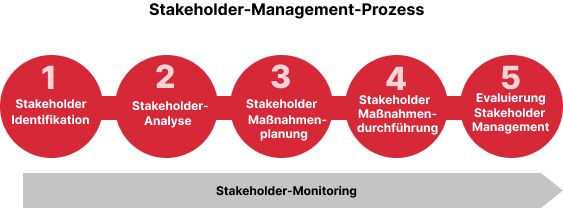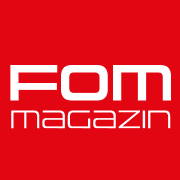Stakeholder management can be complex - but it can also be simple. How? With the right tool. FOM software standardizes dialog processes and approval procedures.
An editorial contribution from the FOM Magazine
Where there are people, there are human beings. Anyone planning a major project or managing a company often has to take a large number of different parties into account - not only their own employees and shareholders, but also politicians and administrators, the media, environmental and nature conservationists, and the general public. All these stakeholders have their own interests and motivations.
Bringing all this together is a challenge, both operationally and in terms of communication. Since the various stakeholders are often geographically far apart - often even spread across the globe - it is not always possible to meet in person.
However, telephone conferences are less personal than face-to-face contact; and it is precisely personal contact that helps to coordinate different interests. Online meetings therefore offer a good intermediate solution.
What is stakeholder management?
Stakeholder management refers to the process by which an organization identifies various external and internal stakeholders and considers them in project planning and execution.
This does not necessarily have to be a specific project. Companies, for example, practice continuous stakeholder management by including the various stakeholders in their operational and strategic considerations.
Source: Peterjohann Consulting
Stakeholder management is also an essential component of risk management, as resistance from the ranks of stakeholders can have a direct impact on the success of the project or company.
To manage stakeholders successfully, they must first be identified. Then one analyzes the interests and needs of the respective stakeholders and takes them into account in the context of project planning. During all these steps, extensive communication with the stakeholders is crucial.

Stakeholder management therefore requires modern dialog formats, which in practice are often implemented with conventional meeting software. In this case, however, all stakeholders involved have to live with the limitations of this software. FOM software is better suited for stakeholder management in many respects.
What are FOMs?
Regular FOM Magazin readers are already in the know, but here again briefly for all newcomers:
FOM stands for Formal Online Meetings, for example digital
or hybrid meetings, discussions and committees. Unlike traditional
Online meetings follow formal requirements or a predefined procedure. Due to these regulations, the requirements for such
Meeting formats significantly more complex.
Various software solutions are available to organize FOMs in a legally secure, cost-efficient and largely automated manner. They map the entire process from the organization of the FOMs to the implementation and follow-up, provide tools for digital decisions, such as legally compliant online voting & elections, participant and voting rights directories, automated minutes and much more.
What do FOMs have to do with stakeholder management?
Even if stakeholder meetings do not always have to comply with formal requirements by law or statute, FOM tools can prove useful in practice. Ordinary meeting software quickly reaches its limits when it comes to stakeholder meetings.
For example, meetings often involve decisions that require democratic voting procedures and tamper-proof minutes. Certain stakeholder meetings also include a large number of participants, for example, if they are directed at the public or involve government bodies. In this case, agenda and speaker management can facilitate meeting governance.
A practical example
Suppose an energy company wants to build a large-scale wind farm. Both internal and external stakeholders must be included in the project plan. These are, for example, authorities such as building departments, decision-makers in the municipalities and communities such as the local council, the local public and media, and also the company's own shareholders.
1. stakeholder lists
The project management must first identify the relevant stakeholders and decision-makers. FOM software contains a segmentable participant directory in which the respective discussion partners are included.
For example, separate participant lists can be set up for media representatives, the local council, local conservation organizations or the responsible building authority. Once the participant lists for the individual stakeholder groups have been created, invitations for meetings can be sent out with just a few mouse clicks.
2. Video conferencing
Afterwards, the project management has to talk to all stakeholder groups individually and find out their interests. Video conferences are suitable for saving time and costs.
3. automated meeting minutes
FOM software creates automated meeting minutes that meeting participants can then download in a protected online portal. This makes it possible to see at any time who was present at the meetings and what decisions were made.
Depending on the FOM software, meeting participants can even confirm the minutes using a digital signature.
For example, the next steps in the process can be agreed in a meeting with the building authority and recorded in the minutes. The head of the office then signs the minutes and the project management can then transparently demonstrate the respective decisions both within the company and to other stakeholders.
4. Reconciliations
Sometimes democratic decisions need to be made in stakeholder meetings. In the case of the wind farm, for example, a public vote could be held on the construction project to find out whether the project is facing headwinds locally or what concerns are being expressed. The voting tools of the FOM software, which allow both public and secret ballots, are suitable for this purpose.
The project management can provide a meeting link for the public to vote. During the meeting, the pros and cons of the project are first presented and experts can have their say. Then the public votes on the project by secret ballot.
One could even require that participants identify themselves by means of an ID card when registering, in order to prove that they actually come from the region and are thus affected by the project. This can prevent the misuse of the vote.
5. Speaker and agenda management
If a meeting takes place with a larger group, for example with the shareholders of the group or the state parliament, the memory management helps with the meeting management. The meeting leader can give the floor to individual participants and enable both audio and video. Agenda management also enables all meeting participants to follow the agenda at any time.
Particularly relevant for consulting companies
In larger projects, stakeholder management is often handled by specialized consulting firms. Consultants should also have FOM software in their repertoire and be trained in the use of the tools. After all, their job is to ensure that the project runs smoothly. FOM software offers the ideal support for this.
How do you use FOM software in your organization? And how do you organize your stakeholder management? Feel free to write to us at contact@fom-magazin.de.






